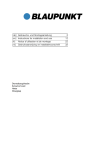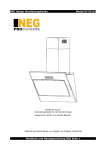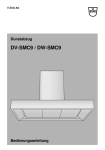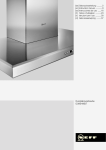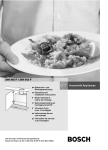Download Bosch DHL535BGB Specifications
Transcript
5750.197 457_Bo Umschl DHL 53… DHL 54… DHL 55… DHL 57… DHL 75… DHL 77… 04.10.2006 13:15 Uhr und de GebrauchsMontageanweisung and en Operating installation instructions de montage fr Notice et d’utilisation en nl Gebruiksmontageaanwijzing per l’uso it Instruzioni e l’installazione de uso es Instrucciones y montaje pt Instruções de Serviço e de Montagem Internet: http://www.bosch-hausgeraete.de Bosch Info-Team: de Tel. 01 80/5 30 40 50 (E 0,12/Min. DTAG) Seite 1 5750.197 457+458.Bo/Si.qxd 24.01.2005 10:08 Uhr Seite 6 Filter und Wartung Aktivkohlefilter Bei Dunstabzugshauben mit zwei Filterkassetten: Achtung: Die Halogenlampen müssen ausgeschaltet und abgekühlt sein. 1. Drücken Sie die Raste an den Fettfiltern in Pfeilrichtung ein und klappen Sie den Fettfilter zuerst nur leicht nach unten. Lösen Sie ihn indem Sie ihn zu sich herziehen. Aus- und Einbauen des Aktivkohlefilters Bei Dunstabzugshauben mit einer Filtermatte: 1. Ausbau des Filters siehe Fettfilter. ❑ Das Drahtgitter wird beim Einbau eines Aktivkohlefilters nicht mehr benötigt. 2. Legen Sie den Aktivkohlefilter auf die Filtermatte und klemmen Sie ihn ein. 2. Reinigen Sie die Fettfilter. 3. Setzen Sie die gereinigten Fettfilter wieder ein. 6 3. Montieren des Filterrahmens. ❑ Siehe Fettfilter. 5750.197 457_Bo Umschl 04.10.2006 13:15 Uhr Seite 2 de Seite 2– 15 it pagna 55– 67 en page 16 – 28 es página 68– 81 fr pages 29 – 41 pt página 82–94 nl pagina 42 – 54 Gebrauchsanweisung: Betriebsarten Abluftbetrieb ❑ Der Lüfter der Dunstabzugshaube saugt den Küchendunst an und leitet ihn durch den Fettfilter ins Freie. ❑ Der Fettfilter nimmt die fettigen Bestandteile des Küchendunstes auf. ❑ Die Küche bleibt weitgehend frei von Fett und Geruch. D Bei Abluftbetrieb der Dunstabzugshaube und gleichzeitigem Betrieb schornsteinabhängiger Feuerungen (wie z. B. Gas-, Öl- oder Kohleheizgeräte, Durchlauferhitzer, Warmwasserbereiter) muss für ausreichend Zuluft gesorgt werden, die von der Feuerstätte zur Verbrennung benötigt wird. Ein gefahrloser Betrieb ist möglich, wenn der Unterdruck im Aufstellraum der Feuerstätte von 4 Pa (0,04 mbar) nicht überschritten wird. Dies kann erreicht werden, wenn durch nicht verschließbare Öffnungen, z. B. in Türen, Fenstern und in Verbindung mit Zuluft-/Abluftmauerkasten oder durch andere techn. Maßnahmen, wie gegenseitige Verriegelung o. ä., die Verbrennungsluft nachströmen kann. Bei nicht ausreichender Zuluft besteht Vergiftungsgefahr durch zurückgesaugte Verbrennungsgase. 2 Ein Zuluft-/Abluftmauerkasten allein stellt die Einhaltung des Grenzwertes nicht sicher. Anmerkung: Bei der Beurteilung muss immer der gesamte Lüftungsverbund der Wohnung beachtet werden. Bei Betrieb von Kochgeräten, z. B. Kochmulde und Gasherd wird diese Regel nicht angewendet. Wenn die Dunstabzugshaube im Umluftbetrieb – mit Aktivkohlefilter – verwendet wird, ist der Betrieb ohne Einschränkung möglich. Umluftbetrieb ❑ Hierzu muss ein Aktivkohlefilter eingebaut werden (siehe Filter und Wartung). Der Aktivkohlefilter kann beim Fachhandel erworben werden (siehe Sonderzubehör auf der letzten Seite). ❑ Der Lüfter der Dunstabzugshaube saugt den Küchendunst an und leitet ihn durch den Fett- und Aktivkohlefilter gereinigt in die Küche zurück. ❑ Der Fettfilter nimmt die fettigen Bestandteile des Küchendunstes auf. ❑ Der Aktivkohlefilter bindet die Geruchsstoffe 5750.197 457+458.Bo/Si.qxd 24.01.2005 10:08 Uhr Seite 16 Instructions for Use Operating modes Before using the first time Exhaust-air mode ! The appliance is not intended for use by young children or infirmed persons without supervision. Young children should be supervised to ensure they do not play with the appliance. ❑ The ventilator fan draws the vapours produced during cooking into the extractor hood, where they pass through the grease filter and out into the open air. ❑ The grease filter absorbs the grease contained in the vapours produced during cooking. ❑ The kitchen is kept almost totally free from grease and odours. Circulating-air mode ❑ An activated carbon filter must be fitted for this operating mode (see Filters and maintenance). Activated carbon filters can be purchased from specialist outlets (see Optional accessories on the last page). ❑ The ventilator fan draws the vapours produced during cooking into the extractor hood, where they pass through the grease filter and the activated carbon filter before the clean air is discharged back into the kitchen. ❑ The grease filter absorbs the grease contained in the vapours produced during cooking. ❑ The activated carbon filter absorbs any odorous substances. Before using the first time Important notes This extractor hood complies with all relevant safety regulations. Repairs should only be carried out by qualified specialists. ! If the connection cable of this appliance is damaged, it must be replaced by the manufacturer, his customer service or a similarly qualified person in order to prevent a hazardous situation. Improperly executed repairs can give rise to significant hazards for the user. 16 ! The appliance should only be connected up to the mains and taken into use by a qualified specialist. ! Dispose of packaging materials properly (see Installation instructions). ! Defective bulbs should be replaced immediately to prevent the remaining bulbs from overloading. ! Light bulbs must always be fitted when the extractor hood is in use. ! Never operate the extractor hood without a grease filter. ! Overheated fat or oil can easily catch fire. If you are cooking with fat or oil, e.g. chips, etc., never leave the cooker unattended. ! Do not flambé food directly under the extractor hood. Risk of grease filter catching fire due to flames. ! ! The hotplates must always be covered with a utensil. ! Restrictions apply to the use of the extractor hood over a solid-fuel burner (coal, wood, etc.). (See Installation instructions). Gas hobs / Gas cookers ! Do not use all the gas hotplates simultaneously for a prolonged period (max. 15 minutes) at maximum thermal load, otherwise there is a risk of burns if the housing surfaces are touched or a risk of damage to the extractor hood. If the extractor hood is situated over a gas hob, operate the hood at maximum setting if three or more gas hotplates are operated simultaneously. 5750.197 457+458.Bo/Si.qxd 24.01.2005 10:08 Uhr Seite 17 How to operate the extractor hood Filters and maintenance ! Various types of grease filter can be used to absorb the grease contained in the vapours produced during cooking. The most effective method of removing vapours produced during cooking is to: ❑ Switch the ventilator ON as soon as you begin cooking. ❑ Switch the ventilator OFF a few minutes after you have finished cooking. Operating controls on different models on off 1 0 2 P Light Intensive setting Fan settings Light P 3 2 1 Fleece grease filter The filter mat is made from material that is itself virtually non-inflammable. Caution: As it becomes more and more saturated with grease however, the filter becomes increasingly inflammable. The efficiency of the extractor hood can also be adversely affected. Important: Renewing the fleece filter at appropriate intervals prevents the possibility of it catching fire as a result of a build-up of heat, such as occurs when deep-fat frying or roasting is taking place. Renewing the fleece filter: ❑ Under normal operating conditions (1 to 2 hours per day), the fleece filter will require replacing after 8 to 10 weeks. Printed fleece filters must be renewed no later than when the coloured printing has started to fade. ❑ Use only original replacement filters. In so doing you will ensure that safety regulations are upheld and the extractor hood performs as effectively as possible. Intensive setting Fan settings Disposing of the old fleece grease filter: ! Fleece grease filters do not contain any pollutants. They can be composted and disposed of as biodegradable waste. Note: The light can be switched on at any time, including when the vapour extractor tray has been pushed back into the hood. 17 5750.197 457+458.Bo/Si.qxd 24.01.2005 10:08 Uhr Seite 18 Filters and maintenance Metal grease filter The filter mat is made of non-combustible metal. Caution: As it becomes more and more saturated with grease, the filter also becomes increasingly inflammable. The efficiency of the extractor hood can also be adversely affected. Important: Clean the metal grease filter at regular intervals. Cleaning the metal filter: Under normal operating conditions (1 to 2 hours per day), the metal grease filter will require cleaning after 8 to 10 weeks. ❑ The filter can be cleaned in a dishwasher. This can however cause slight discoloration. Important: Metal filters that are heavily saturated with grease should not be cleaned at the same time as any crockery, etc. ❑ If the filter mat is going to be cleaned by hand, soak it first of all in a hot detergent solution for several hours. Clean the filter with a brush, rinse it off thoroughly and allow it to drip dry. ❑ Use only original replacement filters. In so doing you will be ensuring that the extractor hood performs as effectively as possible. 2. Press the retaining spring and remove the filter frame. 3. Remove the wire grille and replace the filter mat. Removing and installing the grease filter Extractor hoods with a filter mat: 1. Rotate the handles on the left and right of the filter grille. 18 4. Install the filter frame in reverse sequence. ! Re-attach the retaining spring. ! The left and right sides of the filter frame must lock into position! 5750.197 457+458.Bo/Si.qxd 24.01.2005 10:08 Uhr Seite 19 Filters and maintenance Activated carbon filter Extractor hoods with two filter cartridges: Warning: The halogen bulbs must be switched off and cool. 1. Depress the detent on the grease filters in the direction of the arrow and fold down the grease filter slightly. Detach the grease filter by pulling it towards yourself. Removing and installing the activated carbon filter Extractor hoods with a filter mat: 1. Remove the filter; see grease filter. ❑ The wire grille is no longer required when an activated carbon filter is installed. 2. Place the activated carbon filter on the filter mat and clamp it in. 2. Clean the grease filters. 3. Re-insert the clean grease filters. 3. Install the filter frame. ❑ See grease filter. 19 5750.197 457+458.Bo/Si.qxd 24.01.2005 10:08 Uhr Seite 20 Activated carbon filter Extractor hoods with two filter cartridges: 1. Remove the filter cartridge. ❑ See grease filter. 2. Insert the screw through the wing nut and the sleeve and screw in the middle screw in the false bottom (required only during the initial installation). Screw, sleeve and wing nut are enclosed with the activated carbon filter. 3. Using a screwdriver, press in the two lugs on the false bottom. If a spacer rail has been installed, it must be removed. 4. Tape over the activated carbon filter with the enclosed sealing strip. 20 5. Insert the activated carbon filter at the rear, fold up and lock in the middle with the wing nut. If the spacer rail has been removed, it must be re-installed. 6. Re-insert the two filter cartridges. Removing the activated carbon filter: ❑ The activated carbon filter is removed in reverse sequence. Changing the activated carbon filter: If used normally (1 to 2 hours daily), the activated carbon filter should be changed approx. once a year. Activated carbon filters can be purchased from SPECIALIST OUTLETS (see optional accessories on the last page). Use original filters only. This will ensure optimum performance. Disposing of the old activated carbon filter: Activated carbon filters do not contain any pollutants. They can be disposed of e.g. as residual waste. 5750.197 457+458.Bo/Si.qxd 24.01.2005 10:08 Uhr Seite 21 Cleaning and care Switch off the extractor hood and isolate by pulling out the mains plug or switching off the disconnector on the installation side. ❑ At the same time as you renew the grease filter (see Filters and maintenance), clean off any grease from all accessible parts of the housing. This significantly reduces the fire hazard and ensures that the extractor hood performs as effectively as possible. ❑ Clean the extractor hood with a hot detergent solution or a mild window cleaning agent. ❑ If the hood is extremely dirty (older stains), use a liquid window cleaner. ❑ Do not scratch off dried-on dirt, but wipe off with a damp cloth. ❑ Do not use scouring agents. Warning: Clean the control buttons with a mild detergent solution and a soft, damp cloth only. Painted, aluminium and plastic surfaces: ❑ Do not use scouring agents or abrasive sponges. ❑ Do not use dry cloths. ❑ Do not use corrosive, acidic or alkaline cleaning agents. ❑ Note: Do not use alcohol (spirit) on plastic parts, otherwise the surface may become matt in appearance. ❑ Caution! Ensure that the kitchen is adequately ventilated. Avoid naked flames. Changing the bulbs 1. Switch off the extractor hood and isolate by pulling out the mains plug or switching off the disconnector on the installation side. 2. Remove the filter frame. ❑ See grease filter. 3. Replace the bulb (standard filament bulb, max 40 W, E14 bulb holder). 4. Attach the filter frame. ❑ See grease filter. 21 5750.197 457+458.Bo/Si.qxd 24.01.2005 10:08 Uhr Seite 22 Cleaning and care If you encounter a problem Halogen bulbs: 1. Switch off the extractor hood and isolate by pulling out the mains plug or switching off the disconnector on the installation side. ! When switched on, the halogen bulbs become very hot. Even for some time after the bulbs have been switched off there is still a risk of burns. 2. Remove the bulb ring with a screwdriver or similar tool. 3. Replace the halogen light bulb (conventional halogen bulb, 12 Volt, max. 20 Watt, G4 cap). Caution: Refer to for plug-in lampholder. Take hold of the bulb with a clean cloth. If you have any questions or if a fault occurs, please call Customer Service. (See list of Customer Service representatives). 4. Re-insert the bulb ring. 5. Plug the appliance into the mains or switch it on at the fuse box. Note: If the light does not function, check that the bulbs have been inserted correctly. 22 When you call, please quote the following: E-Nr. FD Enter the relevant numbers into the box above. The E-Nr. (product no.) and FD (production date) are shown on the nameplate which can be seen inside the extractor hood after the filter frame has been detached. 5750.197 457+458.Bo/Si.qxd 24.01.2005 10:08 Uhr Seite 23 Installation Instructions: Important information ! Old appliances are not worthless rubbish. Valuable raw materials can be reclaimed by recycling old appliances. Before disposing of your old appliance, render it unusable. ! You received your new appliance in a Additional information concerning gas cookers: ! When installing gas hotplates, comply with the relevant national statutory regulations (e.g. in Germany: Technische Regeln Gasinstallation TRGI). protective shipping carton. All packaging materials are environmentally friendly and recyclable. Please contribute to a better environment by disposing of packaging materials in an environmentally-friendly manner. Please ask your dealer or inquire at your local authority about current means of disposal. ! Always comply with the currently valid ! The extractor hood can be used in between the upper edge of the trivet and lower edge of the extractor hood: 650 mm. exhaust air or circulating air mode. ! Always mount the extractor hood over regulations and installation instructions supplied by the gas appliance manufacturer. ! Only one side of the extractor hood may be installed next to a high-sided unit or high wall. Gap at least 50 mm. ! Minimum distance on gas hotplates the centre of the hob. ! Minimum distance between electric hob and bottom edge of extractor hood: 650 mm. !The extractor hood must not be installed over a solid fuel cooker – a potential fire hazard (e.g. flying sparks) – unless the cooker features a closed, non-removable cover and all national regulations are observed. min 650 ! The smaller the gap between the extractor hood and hotplates, the greater the likelihood that droplets will form on the underside of the extractor hood. 23 5750.197 457+458.Bo/Si.qxd 24.01.2005 10:08 Uhr Seite 24 Prior to installation Exhaust-air mode The exhaust air is discharged upwards through a ventilation shaft or directly through the outside wall into the open. D Exhaust air should neither be directed into a smoke or exhaust flue that is currently used for other purposes, nor into a shaft that is used for ventilating rooms in which stoves or fireplaces are also located. Local authority regulations must be observed when discharging air into smoke or exhaust flues that are not otherwise in use. D When the extractor hood is operated in exhaust-air mode simultaneously with a different burner which also makes use of the same chimney (such as gas, oil or coal-fired heaters, continuous-flow heaters, hot-water boilers) care must be taken to ensure that there is an adequate supply of fresh air which will be needed by the burner for combustion. Safe operation is possible provided that the underpressure in the room where the burner is installed does not exceed 4 Pa (0.04 mbar). This can be achieved if the combustion air can be replenished by being able to flow through non-closeable openings such as in doors, windows, wall ventilation boxes, or by alternative technical measures such as reciprocally shutting the other device off, etc. An air-intake/exhaust-air wall box by itself is no guarantee that the limiting value will not be exceeded. 24 Note: When assessing the overall requirement, the combined ventilation system for the entire household must be taken into consideration. This rule does not apply to the use of cooking appliances, such as hobs and ovens. All legal requirements concerning the discharge of exhaust air must be observed. Unrestricted operation is possible if the extractor hood is used in recirculating mode – with activated carbon filter. The extractor hood should be fitted with a one-way flap for exhaust-air mode if there is not already one installed in the exhaust-air pipe or wall box. If a one-way flap is not enclosed with the appliance, purchase one from a specialist outlet (see optional accessories on the last page). Attaching the one-way flap ❑ Insert the two lugs on the one-way flap into the holes on the air-pipe connector or air outlet and lock into position. ! Before installing the one-way flap, ensure that the lettering or stamp is on the outside. 5750.197 457+458.Bo/Si.qxd 24.01.2005 10:08 Uhr Seite 25 Prior to installation Optimum performance of the extractor hood: ❑ Short, smooth extraction pipe. ❑ As few pipe bends as possible. ❑ Largest possible pipe diameter (preferably 150 mm ø) and large pipe bends. ❑ Round pipes: We recommend for single-motor model, inner diameter of at least 120 mm for double-motor model. inner diameter of at least 150 mm ❑ Flat ducts must have an inner crosssection equivalent to round pipes which have an inner diameter of 120/150 mm. 120 mm l approx. 113 cm2 150 mm l approx. 177 cm2 ❑ If pipe diameters differ: use sealing strip. ❑ Ensure an adequate air supply for exhaust-air mode. Extractor hoods with 150 mm Ø air outlet: 150 mm l extraction pipe ❑ Screw the reducing connector (see optional accessories on the last page) onto the air outlet. ❑ Attach the extraction pipe to the reducing connector. 150 mm l extraction pipe ❑ Attach the exhaust-air pipe directly to the air outlet.. ! If a one-way flap has been fitted, conduct a performance test. Extractor hoods with rectangular air outlet: ❑ Screw the enclosed air-pipe connector over the air outlet. Pipe connection Extractor hoods with 120 mm Ø air outlet: 100 mm Ø extraction pipe ❑ Insert the reducing connector (see optional accessories on the last page) into the air-pipe connector and then attach the exhaust-air pipe. 120 mm Ø extraction pipe ❑ Attach the exhaust-air pipe directly to the air-pipe connector. Recirculated air mode ❑ The air cleaned by an additional activated carbon filter is conveyed back into the room. ❑ In recirculated air mode the exhaust opening must be protected by a grille (see optional accessories on the last page) in order to prevent a mechanical or electrical hazard. 25 5750.197 457+458.Bo/Si.qxd 24.01.2005 10:08 Uhr Seite 26 Electrical connection Installation The extractor hood must be connected to a correctly installed earthed socket only. Attach the earthed socket as close to the appliance as possible and in an accessible position. If the earthed socket is no longer accessible following installation of the extractor hood, a disconnector must be provided on the installation side. Disconnectors are switches with a contact opening of more than 3 mm and all-pole disconnection. LS switches and contactors are regarded as disconnectors. The appliance must be isolated before repairs are carried out. Repairs may be carried out by authorised technicians only. The extractor hood is particularly suitable for installation in a flue or chimney. To ensure optimum extraction performance (especially important for kitchen island solutions): ❑ Install the extractor hood as high as possible within the structure ❑ The structure must cover the entire cooking area. The following cutouts must be made for the installation depending on the model: Extractor hood with rocker switch, 53 cm wide, 1-motor: ! If the connection cable of this appliance m in 0 is damaged, it must be replaced by the manufacturer, his customer service or a similarly qualified person in order to prevent a hazardous situation. Improper repairs may put the user at considerable risk. Length of connection cable: 1.20 m. Electrical specifications: The electrical specifications can be found on the rating plate inside the appliance when the filter frame has been removed. 1 min 3 60 - 15 2 50 0 -3 16 ! Do not place hand in the air outlet. This appliance complies with the EC radio interference suppression regulations. 248 100 248 120 47 75 160 12 530 75 280 26 256 5750.197 457+458.Bo/Si.qxd 24.01.2005 10:08 Uhr Seite 27 Installation Extractor hood with slide control, 53 cm wide, 1 and 2-motor: m in 5 35 1 min 3 2- Extractor hood with slide control, 73 cm wide, 1 and 2-motor m in 5 15 35 50 0 -3 1 min 2 -3 70 0 -3 16 16 248 150 248 120 348 150 55 35 95 160 9 9 530 380 348 120 55 95 35 160 730 100 225 346 150 496 100 225 380 120 150 346 696 160 310 250 380 530 120 160 230 9 15 230 310 60 80 9 730 60 80 95 95 346 380 250 346 27 5750.197 457+458.Bo/Si.qxd 24.01.2005 10:08 Uhr Seite 28 Installation Removal 1. Remove the filter grille (see operating instructions). 2. Connect the power. 3. Press the extractor hood up into the installation opening until the installation aid locks into position at the front and rear. 4. Screw in the extractor hood. 1. Loosen the screws. 2. Hold the underside of the extractor hood, Hold the underside of the extractor hood. Installation spring 3. Lower the extractor hood and remove. 5. Insert and secure the filter grille (see operating instructions). Weight in kg: Model Width Exhaust air Recircu lated air 1-motor Rocker switch 53 cm 5,0 6,3 1-motor Slide control 53 cm 9,5 10,7 1-motor Slide control 73 cm 10,3 11,6 2-motor Slide control 53 cm 8,3 9,5 2-motor Slide control 73 cm 8,7 9,9 Design changes with respect to technical development shall remain withheld 28 5750.197 457_Bo Umschl 04.10.2006 13:15 Uhr Seite 3 DHZ 2100 280 0 53 280 53 280 53 DHZ 7204 0 0 30 0/7 380 53 380 53 DHZ 7304 DHZ 7305 30 0/7 461423 30 280 5 30 0 0/773 55330/ 3803 80 481051 3030 7 00/7/ 5 533 38308 0 0 28 0 53 095660 38 0 38 0 30 /7 30 5 30 0/7 53 5750.197 457_Bo Umschl 04.10.2006 13:15 Uhr Robert Bosch Hausgeräte GmbH Seite 4 5750 197457 Printed in Germany 1006 Hi.


















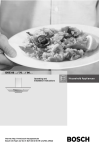
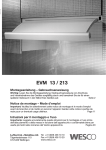
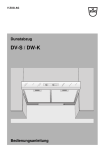
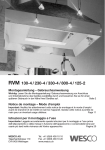

![[de] Gebrauchs- und Montageanleitung 2 [en] Instructions](http://vs1.manualzilla.com/store/data/006783472_1-9623bc8bb4187c1cd6f5b4be12ce6579-150x150.png)
